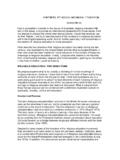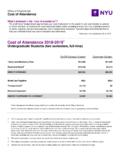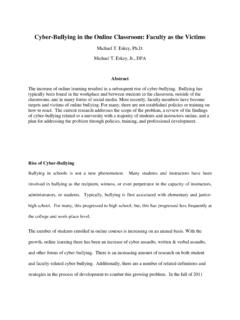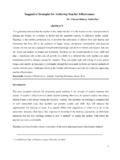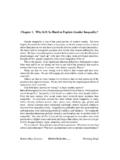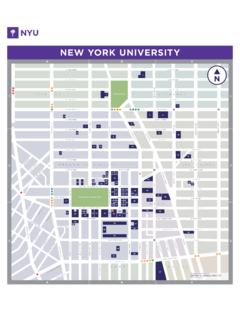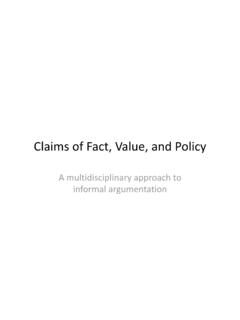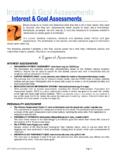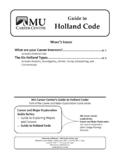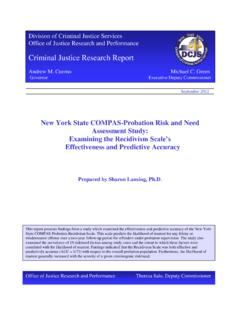Transcription of WHAT IS RESEARCH DESIGN? - nyu.edu
1 PART IWHAT IS RESEARCH DESIGN? 1 THE CONTEXT OF DESIGNB efore examining types of RESEARCH designs it is important to be clearabout the role and purpose of RESEARCH design. We need to understandwhat RESEARCH design is and what it is not. We need to know wheredesign ts into the whole RESEARCH process from framing a question to nally analysing and reporting data. This is the purpose of this and explanationSocial researchers ask two fundamental types of RESEARCH questions:1 Whatis going on (descriptive RESEARCH )?
2 2 Whyis it going on (explanatory RESEARCH )?Descriptive researchAlthough some people dismiss descriptive RESEARCH as `mere descrip-tion', good description is fundamental to the RESEARCH enterprise and ithas added immeasurably to our knowledge of the shape and nature ofour society. Descriptive RESEARCH encompasses much government spon-sored RESEARCH including the population census, the collection of a widerange of social indicators and economic information such as householdexpenditure patterns, time use studies, employment and crime statisticsand the can be concrete or abstract.
3 A relatively concrete descrip-tion might describe the ethnic mix of a community, the changing agepro le of a population or the gender mix of a workplace. Alternativelythe description might ask more abstract questions such as `Is the level ofsocial inequality increasing or declining?', `How secular is society?' or`How much poverty is there in this community?'Accurate descriptions of the level of unemployment or poverty havehistorically played a key role in social policy reforms (Marsh, 1982). Bydemonstrating the existence of social problems, competent descriptioncan challenge accepted assumptions about the way things are and canprovoke description provokes the `why' questions of explanatoryresearch.
4 If we detect greater social polarization over the last 20 years( the rich are getting richer and the poor are getting poorer) we areforced to ask `Why is this happening?' But before asking `why?' we mustbe sure about the fact and dimensions of the phenomenon of increasingpolarization. It is all very well to develop elaborate theories as to whysociety might be more polarized now than in the recent past, but if thebasic premise is wrong ( society is not becoming more polarized) thenattempts to explain a non-existent phenomenon are course description can degenerate to mindless fact gathering orwhat Mills (1959) called `abstracted empiricism'.
5 There are plentyof examples of unfocused surveys and case studies that report trivialinformation and fail to provoke any `why' questions or provide any basisfor generalization. However, this is a function of inconsequentialdescriptions rather than an indictment of descriptive RESEARCH researchExplanatory RESEARCH focuses onwhyquestions. For example, it is onething to describe the crime rate in a country, to examine trends over timeor to compare the rates in different countries. It is quite a different thingto develop explanations about why the crime rate is as high as it is, whysome types of crime are increasing or why the rate is higher in somecountries than in way in which researchers develop RESEARCH designs is funda-mentally affected by whether the RESEARCH question is descriptive orexplanatory.
6 It affects what information is collected. For example, if wewant to explain why some people are more likely to be apprehended andconvicted of crimes we need to have hunches about why this is so. Wemay have many possibly incompatible hunches and will need to collectinformation that enables us to see which hunches work best the `why' questions involves developingcausalexplana-tions. Causal explanations argue that phenomenonY( income level)is affected by factorX( gender). Some causal explanations will besimple while others will be more complex.
7 For example, we might arguethat there is adirecteffect of gender on income ( simple genderdiscrimination) (Figure ). We might argue for a causal chain, such asthat gender affects choice of eld of training which in turn affects2 WHAT IS RESEARCH DESIGN? occupational options, which are linked to opportunities for promotion,which in turn affect income level (Figure ). Or we could posit a morecomplex model involving a number of interrelated causal chains ( ).Prediction, correlation and causationPeople often confuse correlation with causation.
8 Simply because oneevent follows another, or two factors co-vary, does not mean that onecauses the other. The link between two events may be coincidental ratherthan is a correlation between the number of re engines at a re andthe amount of damage caused by the re (the more re engines the moredamage). Is it therefore reasonable to conclude that the number of reengines causes the amount of damage? Clearly the number of reengines and the amount of damage willbothbe due to some third factor such as the seriousness of the , as the divorce rate changed over the twentieth century thecrime rate increased a few years later.
9 But this does not mean thatdivorce causes crime. Rather than divorce causing crime, divorce andcrime rates might both be due toothersocial processes such as secular-ization, greater individualism or ) Direct causal relationshipGenderField oftrainingOccupationPromotionopportuniti esIncomelevelb) Indirect causal relationship: a causal chainc) A more complex causal model of direct and indirect causal linksGenderChild-careresponsibilityOccup ationPart time or fulltime workIncomelevelField oftrainingFigure types of causal relationships3 THE CONTEXT OF DESIGNS tudents at fee paying private schools typically perform better in their nal year of schooling than those at government funded schools.
10 But thisneed not be because private schoolsproducebetter performance. It maybe that attending a private school and better nal-year performance areboththe outcome of some other cause (see later discussion).Confusing causation with correlation also confuses prediction withcausation and prediction with explanation. Where two events or charac-teristics are correlated we can predict one from the other. Knowing thetype of school attended improves our capacity to predict academicachievement. But this does not mean that the school type affects aca-demic achievement.
